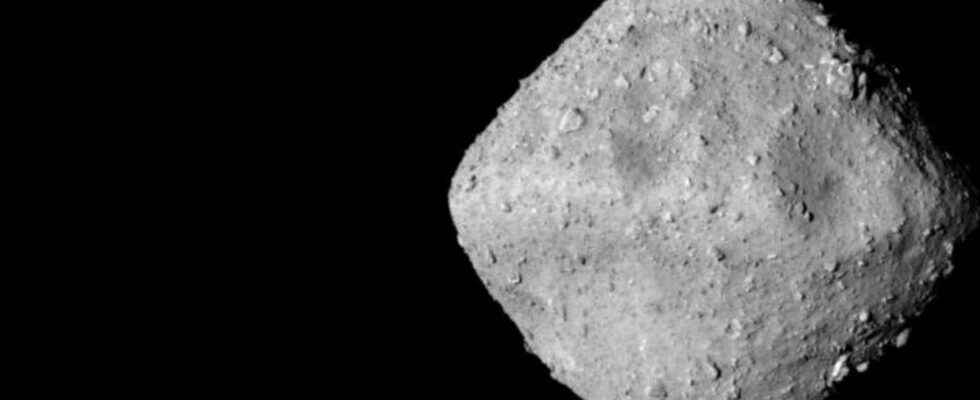In 2019, nearly 200 million kilometers from our Earth, a Japanese probe – the Hayabusa-2 probe – landed on a asteroid to collect some samples. Just over five grams in all. Rocks and dust from the ground and subsoil of the one that the astronomers know as Ryugu. It is considered the most primitive object of the Solar system that researchers have never studied.
Since return of these samples to Earth in December 2020, astronomers are carrying out detailed analyses. And they confirm today to have discovered there a significant number ofamino acids. Amino acids – the building blocks of proteins and therefore, essential to life – likely to spread in the surroundings, carried by dust. Of the’isoleucine and some valinefor example, amino acids that are considered essential for the functioning of the human body. But that he is not able to synthesize alone.
Three years ago today (February 22, 2019) was the first touchdown of Hayabusa2! We remember the extremely tense operation. The sample collected at that time is now being examined by our initial analysis team. We are excited about what we will find! pic.twitter.com/tvmyBnHOzk
— HAYABUSA2@JAXA (@haya2e_jaxa) February 22, 2022
A proof of the extraterrestrial origin of life?
For a long time, researchers have considered that amino acids – and other molecules organic – may have been brought to Earth by asteroid impacts or comets. But they struggled to prove it because of the contamination fast meteorites over there matter earthly. This time, they clearly show that this type of molecule essential to life can exist in space.
What make researchers even more impatient to study the samples taken by the Osiris-Rex mission (Nasa) on theBennu asteroid. Some 60 grams of precious rocks that should arrive in laboratories by 2023.
Ingredients of life found in samples from asteroid Ryugu
The Hayabusa-2 probe left in 2014 to study the asteroid Ryugu. And bring some samples back to Earth. Mission accomplished in December 2020. From now on, the researchers will take the time to analyze them. Early results suggest they are rich in life-giving ingredients.
Article of Nathalie Mayer published on 06/27/2021
Last December, Hayabusa-2, a probe of the Japanese Space Agency (Jaxa), dropped a capsule on Earth containing just over five grams of valuable samples. Those of theasteroid Ryugu. Since then, the teams chosen to analyze them have been stamping their feet with impatience. A little more after the publication of some images of these samples at the very end of the year.
Researchers from Okayama University (Japan) received their share in preview – seven other teams will soon receive their samples – on June 2, 2021. And they immediately measured the amount ofhydrogen atomscarbon andnitrogen contained in rocks and sand from Ryugu. Data that they then converted into the quantity of water and organic matter likely to have been formed. In the end, large quantities…
In December last year, we began to analyze samples from asteroid Ryugu brought back to Earth by @haya2e_jaxa. In June, part of the sample was formally delivered to specialized research teams in Japan, who will be part of the initial analysis. https://t.co/4lAXIbaGsU
— Martian Moons @JAXA (@mmx_jaxa_en) June 21, 2021
Explain the origin of life on Earth
This work confirms Jaxa’s preliminary observations. It is possible that a significant amount of ice existed on Ryugu. But the analysis has only just begun. The teams will study the samples returned from the asteroid for an entire year. Looking for clues that could explain theorigin of water on earth. And in hopes of identifying organic matter.
Professor Tachibana Shogo of the University of Tokyo, coordinator of the research efforts, hopes that analysis of these samples will yield various pieces of evidence that will provide clues to the origins of the Solar system and life on Earth and how the oceans were created. Especially since in parallel, Rikkyo University researchers (Japan) have just shown that Ryugu is about as porous as were the planetesimals that led to the formation of the planets.
Special offer: for Father’s Day, offer the best of Science!
Your father is a great science enthusiast and unusual discoveries? And if you offer him a superb scientific exploration in paper format? Benefit from -20% on the Mag Futura (special offer: €15 instead of 19 €): 220 pages to explore 4 scientific issues that will shape our future!
Mag Futura is:
- 4 major scientific questions for 2022, from the Earth to the Moon
- 220 pages, 60 experts: no fake news, just science
- Home delivery with electronic gift card
- An independent scientific media
Interested in what you just read?
